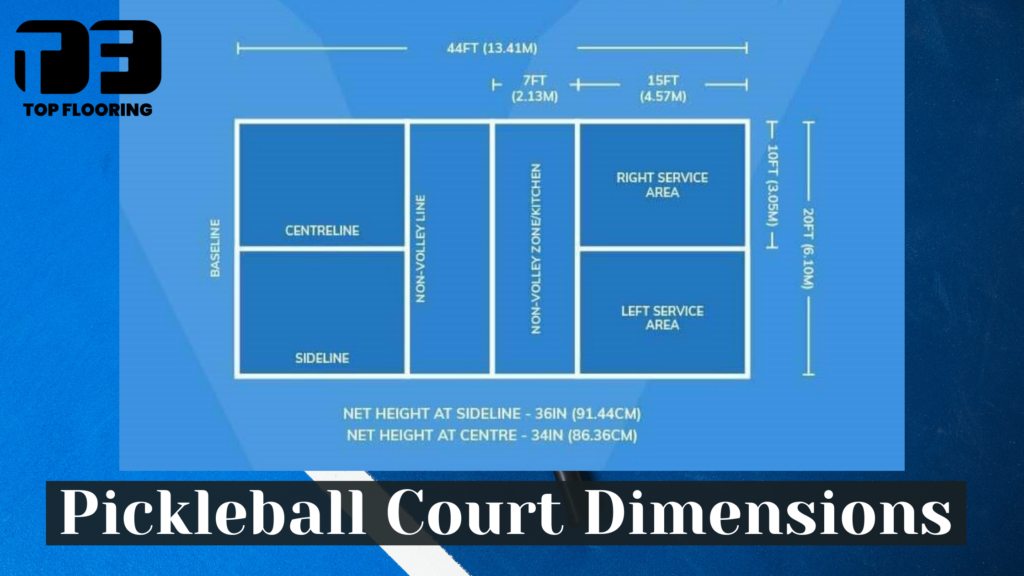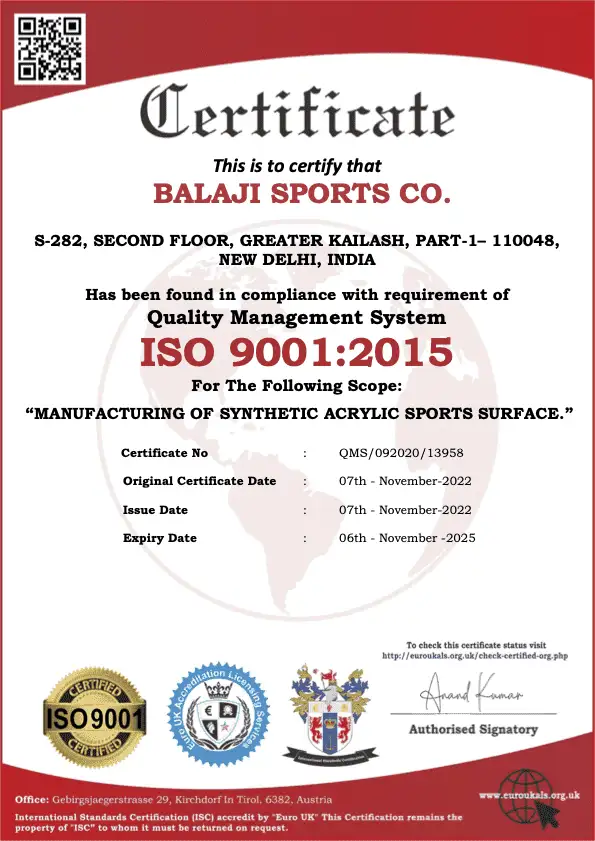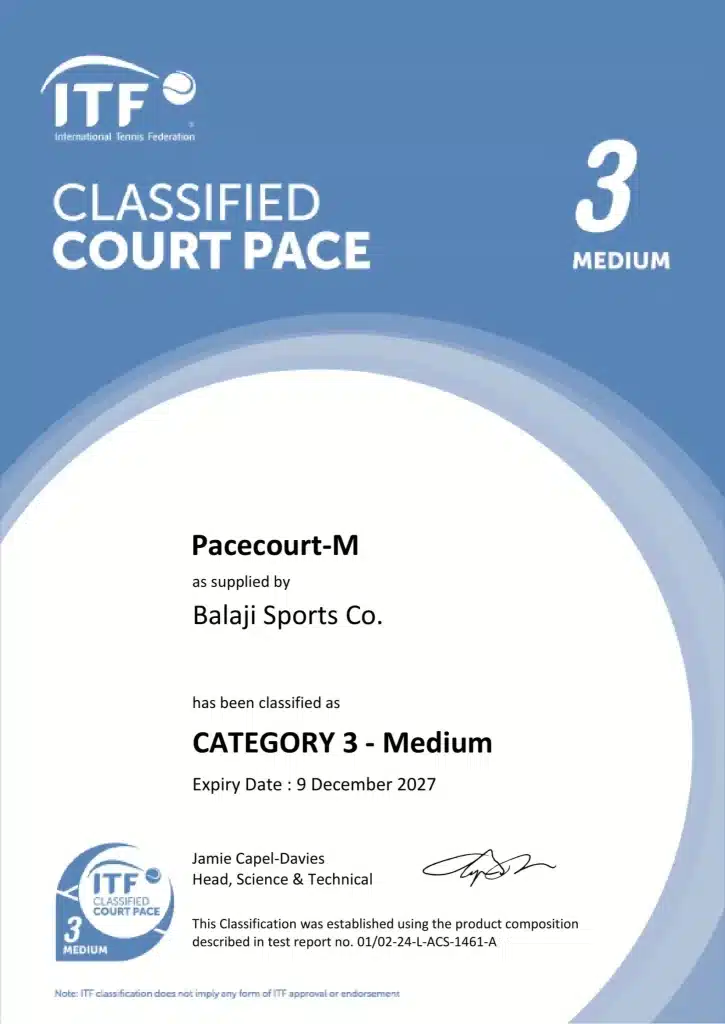Pickleball is quickly becoming globe’s fastest-expanding sports. The simplicity of its rules, quick play, and low equipment cost making it preffered choice from the older to the younger ones. It is a combination of tennis, badminton, and table tennis, offering players an interesting as well as testing experience. Whether you are building a recreational court or a commercial outdoor pickleball court, it is important to know official pickleball court dimensions to ensure proper layout, hassle-free play, and compliance with international standards.
At Top Flooring, we specialize in providing top-notch acrylic pickleball court floors that are performance-driven, durable, and safe. With 14 years of experience, we cover over 800 thousand square feet of built-up area and 2000+ completed projects. Top Flooring featuring 9 standard court colours and color customization options. As a manufacturer of ITF and ISO-certified material, which is made in India, Top Flooring specializes in the layer system; whether you choose 5, 6, 7, 8, or 9, our professionals design your pickleball court using best method. But before moving through the best surface solutions, it is vital to know about the size and design of the pickleball court so that you can make your project accordingly.
Official Pickleball Court Size and Layout (20 × 44 ft)
An official pickleball court comes in 20 feet wide (that’s 6.1 metres, for those metric folk) and 44 feet long (which is 13.4 metres, or roughly 13.5 metres) – exactly the same for both singles and doubles. That compact size is one of the reasons pickleball is so easy to get into and so fast-moving. Every single line and zone on the court has a specific job to do, balancing out movement, rally space and making sure players stay safe.
To get a court that meets international standards, you need to plan for both the playing area and the space all round it where players can run around without crashing into the wall. The lines that define the 20×44 ft area are clear, but you need a bit of extra clearance to make sure you’ve got room to move around and stay safe while playing.
| Court Element | Measurement | Purpose |
|---|---|---|
| Overall Court Size | 20 ft × 44 ft (6.10 m × 13.41 m) | Regulation size for singles and doubles |
| Playing Area (with Run-off) | 30 ft × 60 ft minimum (9.14 m × 18.29 m) | Recommended recreational space |
| Tournament Area | 34 ft × 64 ft (10.36 m × 19.51 m) | Ideal for professional venues |
| Non-Volley Zone (“Kitchen”) | 7 ft from net on each side | Restricts volleying close to net |
| Service Area | Two equal boxes (10 ft × 15 ft) per side | Divided by the centerline |
| Net Height | 36 in (0.91 m) at posts / 34 in (0.86 m) at center | Slight center dip for fair play |
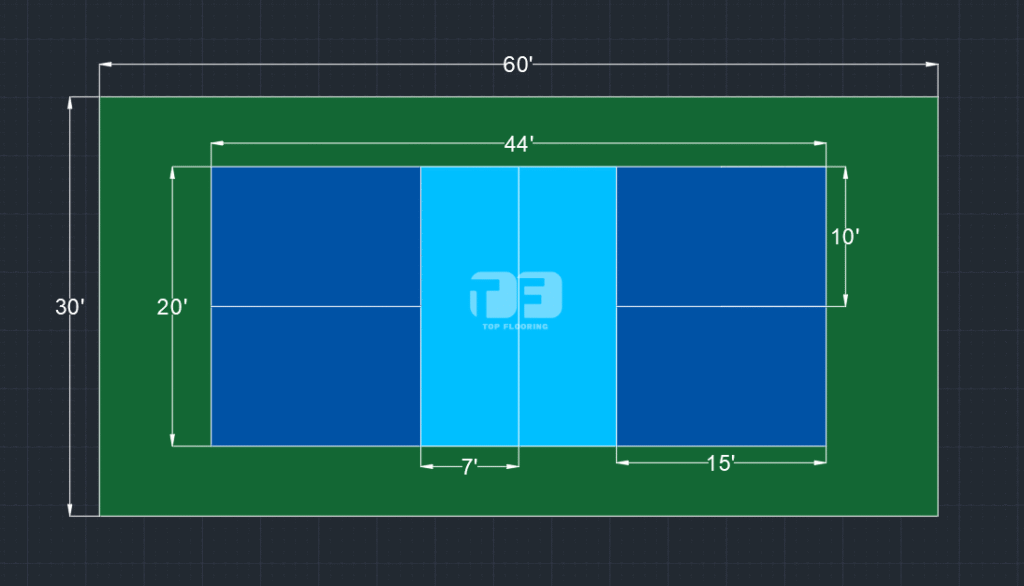
Pickleball Court Dimensions in Feet and Meters
Whether your court is indoors or outdoors, pickleball courts everywhere follow the same layout as set out by the USA Pickleball Association (USAPA). That standard has been adopted all over the world, including in India. And the dimensions of the official pickleball court – 20 feet by 44 feet – that size works just fine for singles and doubles games alike.
To make planning and building your own pickleball court easier, here are the key dimensions you need to know both in feet and meters:
| Pickleball Court Element | Measurement (Feet) | Measurement (Meters) |
|---|---|---|
| Overall Court Size | 20 ft × 44 ft | 6.10 m × 13.41 m |
| Playing Area (Recreational) | 30 ft × 60 ft | 9.14 m × 18.29 m |
| Playing Area (Tournament) | 34 ft × 64 ft | 10.36 m × 19.51 m |
| Non-Volley Zone (Kitchen) | 7 ft each side of net | 2.13 m |
| Service Box (Each Half) | 10 ft × 15 ft | 3.05 m × 4.57 m |
| Net Height – Sidelines | 36 in | 0.91 m |
| Net Height – Center | 34 in | 0.86 m |
| Baseline to Net Distance | 22 ft | 6.71 m |
Key Zones and Line Markings Explained
A well marked pickleball court is fair, safe and consistent for every rally. Each line and zone has a purpose, a balance between fast play and strategy. According to international standards all lines and zones should be 2 inches (5 cm) wide and painted in a contrasting acrylic color to the court surface.
1. Baseline
The baseline runs parallel to the net at the back of the court, the limit of play. Players must stand behind the baseline when serving.
- Measurement: 20 ft wide (6.10 m)
- Tip: Leave 3–5 ft of safety run-off behind this line for smooth player movement.
2. Sidelines
Sidelines define the sides of the 20 × 44 ft playing rectangle.
- Measurement: 44 ft (13.41 m)
- Purpose: They mark in-bounds for both singles and doubles since pickleball uses the same width for both game formats.
3. Non-Volley Zone (Kitchen)
The non-volley zone, also known as the “kitchen”, is 7 ft (2.13 m) on each side of the net. Players cannot volley (hit the ball in the air) while standing in this area.
- Why It Matters: This zone controls aggressive net play and fair, strategic rallies.
- Marking Tip: Use textured acrylic paint to avoid fading under UV light.
4. Centerline
The centerline divides each side of the court into two equal service boxes — left and right.
- Measurement: 15 ft long (4.57 m)
- Purpose: Guides accurate serving and rotation between points.
- Pro Tip: Extend the centerline 2 inches beyond the kitchen line for visibility during matches.
5. Service Courts
Each side has two service boxes, defined by the centerline, baseline and non-volley zone line.
- Size: 10 ft × 15 ft each (3.05 m × 4.57 m)
- Purpose: The ball must land diagonally across in the opponent’s service box after a serve.
- Construction Tip: Make sure these zones are level for consistent bounce.
6. Net & Post Alignment
The net divides the court in half, at 36 inches (0.91 m) high at the sidelines and 34 inches (0.86 m) at the center.
- Check: Posts should be outside the sidelines, not inside the 20 ft width.
- Material: Powder-coated steel or aluminum posts with tension adjusters for Indian weather.
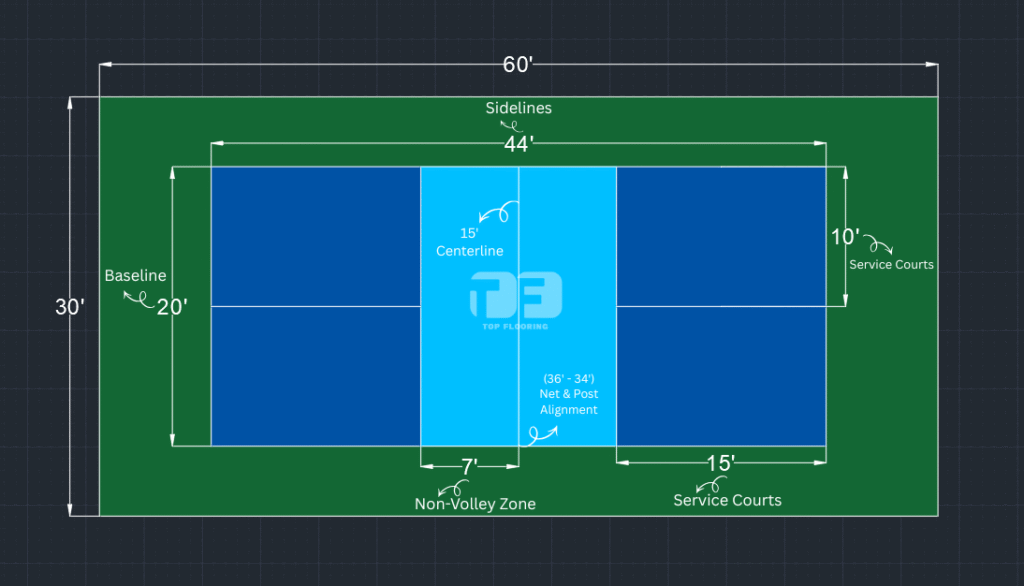
Check Pickleball Court Key Zones and Markings
Outdoor Pickleball Court Flooring Options in India
When putting together an outdoor pickleball court in India, deciding on the right surface material is pretty much make-or-break for both performance and longevity. India’s climate is as tough as nails — boiling summers, torrential rains – and it demands a court system that can withstand all that and still perform consistently every month of the year.
Among the outdoor flooring options available, synthetic acrylic systems have proven to be the one that really gets the job done for pickleball courts. These multi-layer coatings get the perfect balance of grip, cushioning and UV stability just right so you can play safely and enjoy yourself to the max.
1. Acrylic Sports Flooring – Highly Recommend
The standard choice for outdoor pickleball courts, acrylic flooring, is made using a blend of acrylic resins, silica sand and cushion coats that create a flexible yet durable surface that’s sure to please. It’s a no-brainer for outdoor pickleball, in our opinion.
- Weather-Resistant: Durable enough to withstand extreme sunlight, heavy rainfall and crazy temperature swings.
- Player Safety: The non-slip texture is a real lifesaver – reduces the risk of falls and gives your foot that extra grip.
- Performance: The ball bounce is spot on and consistent all over the surface – which is just what you need for a top-notch game.
- Low Maintenance: Just needs the occasional clean and a new coat every 4–5 years.
Acrylic coatings are water-based, eco-friendly, and easily adaptable to both concrete and asphalt bases – making them the perfect choice for Indian schools, housing societies, clubs, and stadiums.
2. Polyurethane (PU) Flooring – A Good Option for Indoor Use
PU has a cushioned layer which makes it suitable for multi-sport facilities with moderate use. But let’s be honest, it’s less UV-resistant than acrylic – and can go yellow or crack if left out in direct sunlight for too long.
- Best For: Indoor pickleball or a shaded recreational court.
- Limitation: Not a great choice for open outdoor use in Indian climates.
3. Modular PP Tiles – Not First Choice
Those interlocking polypropylene tiles are quick to lay and are often used for temporary or multi-purpose courts. On the plus side, they do allow good drainage but they can feel pretty hard underfoot and can alter the ball bounce.
- The Good: Easy installation and portability.
- The Not So Good: Limited shock absorption – and the bounce can be all over the shop.
4. Asphalt or Concrete Base (Sub-surface Only)
A good foundation is essential before you even think about applying a surface coating. Both m20-grade concrete and asphalt bases make a solid sub-layer for acrylic flooring.
- Concrete Base Thickness: We like to see 100–125 mm reinforced with steel mesh.
- Slope: 1:100 gradient is ideal for drainage.
Surface Prep: Must be clean, dry and level before you even think about applying any acrylic.
Why Choose Acrylic for Outdoor Pickleball Court Surface?
The surface of a pickleball court is the key to safety, comfort and overall gameplay. In India where outdoor conditions can be harsh acrylic pickleball court flooring has proven to be the best option. It performs well in all seasons and gives long term value to facility owners.
Here’s why acrylic is the best surface for outdoor pickleball courts:
1. Weather Resistance that Lasts
Outdoor courts are exposed to changing weather conditions from scorching summer to heavy rainfall. Acrylic surfaces are engineered with UV stable materials that resist cracking, fading or peeling even in extreme climates. This ensures the court looks and performs year after year with minimal resurfacing required.
2. Safe Play for All Ages
One of the most important aspect of any sports surface is player safety. Acrylic pickleball courts have anti-slip texture that reduces the risk of skids or falls even when the surface is slightly damp. This makes them ideal for schools, residential complexes and community centers where players of all ages, children, adults and seniors, play the game.
3. Consistent Game Performance
Pickleball demands precision and fairness and the surface quality directly impacts playability. Acrylic flooring provides a smooth level base that ensures consistent ball bounce and true rallies. Whether its a casual game in a backyard court or a high level tournament players can rely on the surface to deliver professional grade performance every time.
4. Customizable Designs and Aesthetics
Acrylic surfaces are not just functional they also add to the appeal of a facility. Available in a wide range of colors and finishes they can be customized to reflect a school’s branding, a sports club’s identity or even a community park’s vision. A well designed pickleball court doesn’t just improve play it becomes a visual highlight of the space.
5. Low Maintenance Advantage
Unlike traditional materials like asphalt or concrete which can wear out or require expensive maintenance acrylic pickleball flooring is low maintenance. Simple cleaning routines are enough to keep the surface looking and performing like new. This makes it a cost effective solution in the long run especially for high use courts in clubs, stadiums and housing societies.
Benefits of Top Flooring’s Synthetic Acrylic Pickleball Systems
When it comes to building courts that last and perform at the highest level, the surface is key. Top Flooring’s acrylic pickleball court flooring is designed to meet international standards and India’s climate. Here are the benefits that make it the go-to surface for public and private installations:
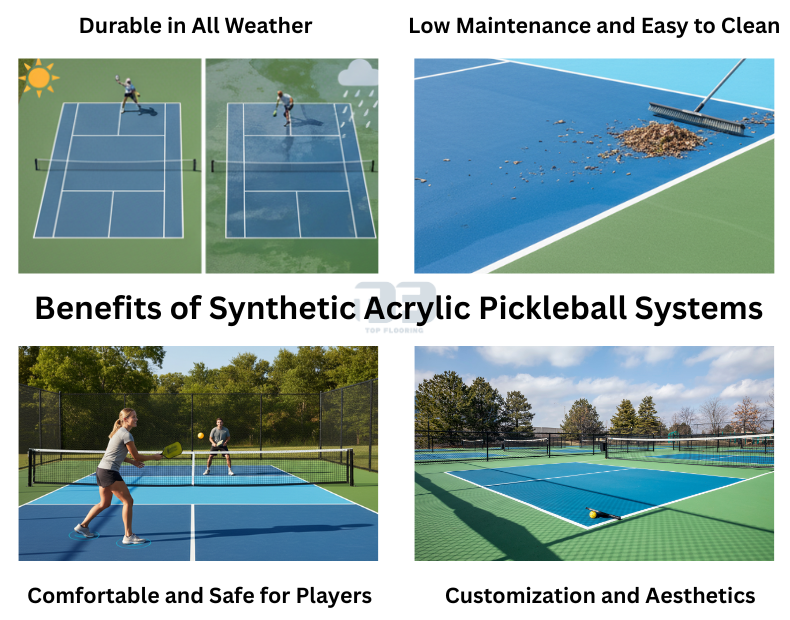
1. Durable in All Weather
Acrylic coatings can withstand years of use without losing their quality. Whether it’s heavy foot traffic, scorching sun or heavy rain, Top Flooring’s outdoor pickleball court flooring systems can handle it. This means longer life for the court and less resurfacing or repairs.
2. Low Maintenance and Easy to Clean
Unlike traditional surfaces that need costly maintenance, acrylic pickleball courts are low maintenance. A simple clean and the surface looks sharp and performs consistently. This is a cost effective option for schools, sports clubs, housing societies and large stadiums where courts are used continuously.
3. Comfortable and Safe for Players
Player comfort is as important as surface durability. Acrylic courts are designed with shock absorbing properties that reduce joint strain and player fatigue. This reduces the risk of injury and allows longer play sessions – an advantage for casual players and competitive athletes.
4. Customization and Aesthetics
Top Flooring offers a wide range of colors and finishes to give each court a unique identity. Whether it’s matching a school’s branding, enhancing a community park or giving a sports club a professional look, custom finishes ensure the court is not only functional but also looks great.
Step-by-Step Guide to Pickleball Court Construction
Building a pickleball court involves more than just marking lines on the ground. Every step, from design to finishing touches, impacts the court’s durability, safety, and overall playing experience. If you’re planning a court for your community, school, club, or even your own backyard, here are some important tips to guide the process:
- Work with Experienced Professionals
The success of pickleball project depends heavily on who builds it. Engaging with professional pickleball court manufacturer like Top Flooring ensures the court is constructed according to international standards. We understand the details of base preparation, dimensions, and surface installation reducing costly mistakes and ensuring long-term performance. - Choose Quality Acrylic Materials
Not all pickleball surfaces are created equal. High-quality acrylic pickleball court flooring delivers superior grip, consistent ball bounce, and resistance to wear. Investing in top-grade materials may cost a little more initially, but it saves money in the long run by reducing maintenance and resurfacing needs. - Ensure Proper Drainage and Leveling
A strong base is essential for any outdoor pickleball court. Adequate site leveling and effective drainage systems prevent water from pooling on the surface. Without this, even the best surface materials can crack, bubble, or lose traction over time. A well-prepared base ensures your court remains safe and durable through all seasons. - Think Beyond the Court Surface
A complete pickleball facility requires more than just flooring. Adding fencing, lighting, and seating not only enhances safety but also improves the overall player and spectator experience. These small details turn a simple court into a professional-quality venue for both recreation and competition.
Conclusion
Since pickleball continues to become popular in India, you need to invest in properly sized courts that have quality surfaces. Familiarity with standard court measurements ensures you have a consistent, quality playing venue. From pickleball court design and line painting to durable acrylic pickleball court surfacing, every one of these components contributes to the court experience. At Top Flooring, we combine meticulous court design with quality materials in order to give courts that look great and last.
Ready to construct your pickleball court? Contact Top Flooring today for expert consultation, customization, and a quote tailored to your site and budget.
Frequently Asked Questions
According to the rules, a pickleball court should have a length of 44 feet, and it should be 20 feet wide, whether it is used for singles or doubles.
Yes, tennis courts can be converted into pickleball court sizes with some marking and layout changes, particularly in multisport centers.
Prices for constructing a pickleball court in India depend on the place, materials, and other facilities, but they range from Rs 3.5 lakh to Rs 7 lakh for a normal outdoor acrylic court.
Yes, a backyard pickleball court is perfect for personal enjoyment and practice if there is an area of 30 ft x 60 ft of acrylic flooring.

